Implementing Clean Architecture - Are Asp.Net controllers "Clean"?
18 Mar 2018
In the previous post I have discussed controllers and presenters. I have shown you how I have implemented my controllers and presenters in the Athena project.
I was quite happy with my design so far but there was one thing which puzzled me …
In Asp.Net MVC a controller derives from System.Web.Mvc.Controller which creates a dependency from my controller to the Asp.Net
framework. Taking the Dependency Rule strict that either means my design is invalid or my controller actually belongs to the
“frameworks” circle.
In order to learn what others think about this design I have posted my question at StackOverflow and had a discussion with @herbertograca.
In this post I will share what I have learned and how I solved the puzzle …
Status quo
In the previous post I have shown you this picture:
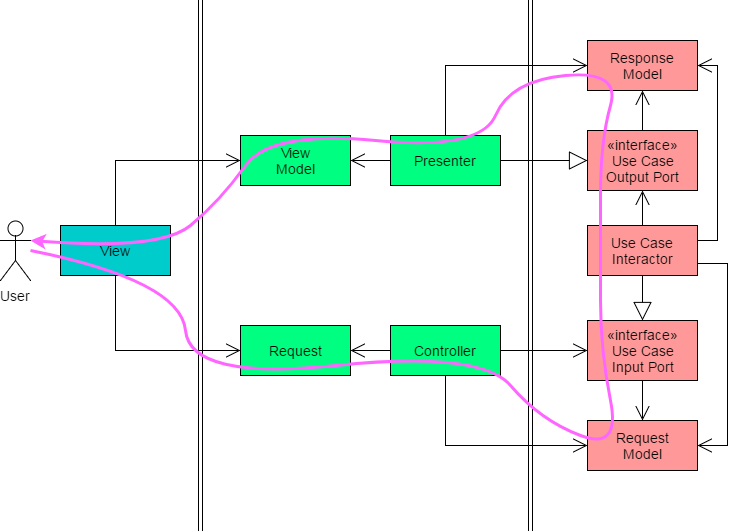
It illustrates very clearly how the control flow from the user to the interface adapter and back to the user works in the Clean Architecture. It also shows how code dependencies should be organized.
I have then shown you some F# code which basically implemented this picture. In the end of the post I had request and response objects, request and response models, a controller and a presenter.
What I have not shown you explicitly were the dependencies the code had to the Asp.Net framework. Let me do this now:
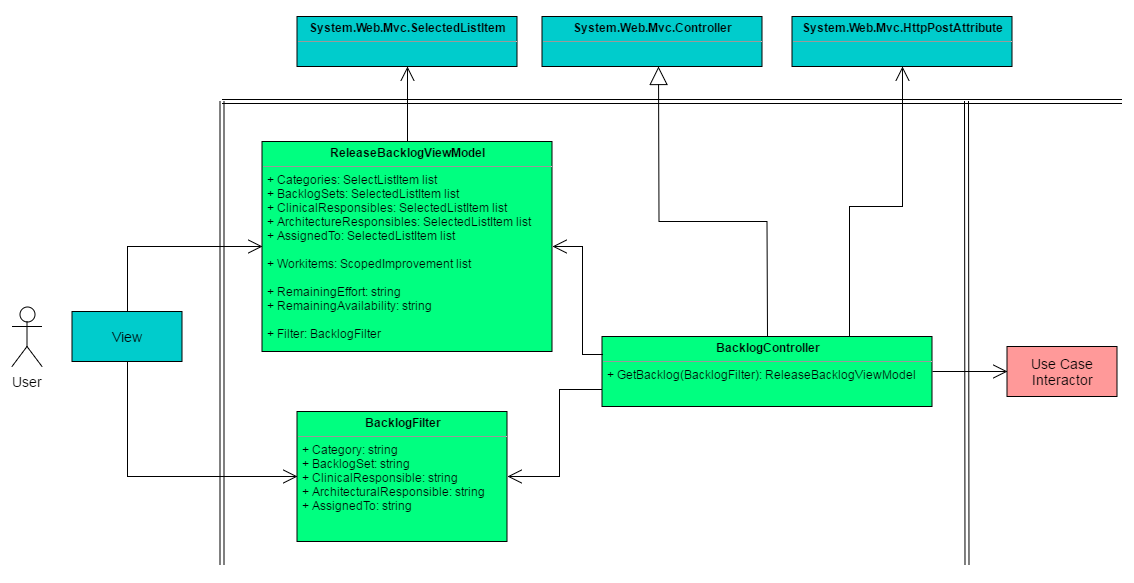
Note: In this picture the BacklogPresenter is part of the BacklogController as it is still kind of “private” class controlled by the BacklogController.
This picture clearly shows that on the one hand the control flow and the dependencies between my classes from Athena project are pretty much conform with the Clean Architecture and the Dependency Rule. On the other hand the color coding makes it obvious that the dependency between my classes and the Asp.Net classes breaks the Dependency Rule.
I see basically three options to handle this situation …
Option 1: Keep the design and accept the violation of the Dependency Rule
Choosing this option means that I would continue implementing my Clean Architecture controllers as derived classes from Asp.Net Controller
and that I would continue using Asp.Net view model classes like SelectListItem. I would continue ensuring that the control flow
and the dependencies between my own classes matches Clean Architecture and Dependency Rule. And of course I would have to accept this
(small) violation of the Dependency Rule.
This approach is a rather simple, pragmatic and convenient one. All the data conversion logic remains in the “interface adapters” layer and I could continue using the benefits of Asp.Net framework.
But of course there are drawbacks. The more I use the convenience of the Asp.Net framework the more my code of course depends on the framework. If I would ever want to migrate to another framework - like Asp.Net Core or Suave.IO or NancyFx - this would have quite some impact on my controller and presenter implementations.
Another aspect would be testing. Today I don’t do much testing on controller and presenter layer. As all my business logic is in the interactors I have focused most of my testing efforts on these interactors. Even if my controllers and presenters do data conversion only there could be bugs and certainly testing this “logic” as well would be beneficial. But testing can become rather difficult if the controller utilizes many APIs from Asp.Net base class (e.g. Request and Session property). How do I fake all these APIs correctly?
There is another observation I have made in my code base: my presenter logic tends to spread across multiple “helper” classes. As the Razor engine supports executing C# code from the HTML templates it is quite convenient to add custom types to view models and have some rendering functions which extract the relevant information and convert it into strings. This convenience made the view far less “dumb” than it should be (Is the view calling the right function? Has the view model property the correct type to be passed to a function?).
Option 2: Keep the design but move the code into the framework layer
The simplest solution towards a design which is conform with the Dependency Rule would be to move the BacklogController and the
ReleaseBacklogViewModel from the “interface adapters” layer into the “frameworks” layer. This would mean that all the data
conversion logic goes into the “frameworks” layer and the “interface adapters” layer becomes rather empty.
Looking at the current project structure of the Athena
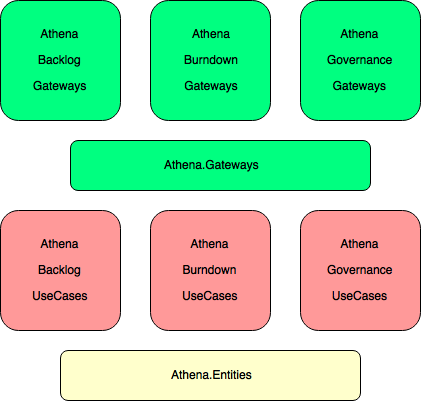
I would probably add a new layer of assemblies, e.g.: Athena.Backlog.AspNet.dll to make the design decision explicit in the code.
This approach is also simple, pragmatic and convenient. But having so much “application logic” in the “frameworks” layer makes the code base more ugly from my perspective.
And of course the other problems mentioned above about testing and complexity are not solved either.
Option 3: Change the design and separate the concerns
The last and cleanest option I see would be to separate my controller and presenter logic from the Asp.Net framework. A first attempt could look like this:
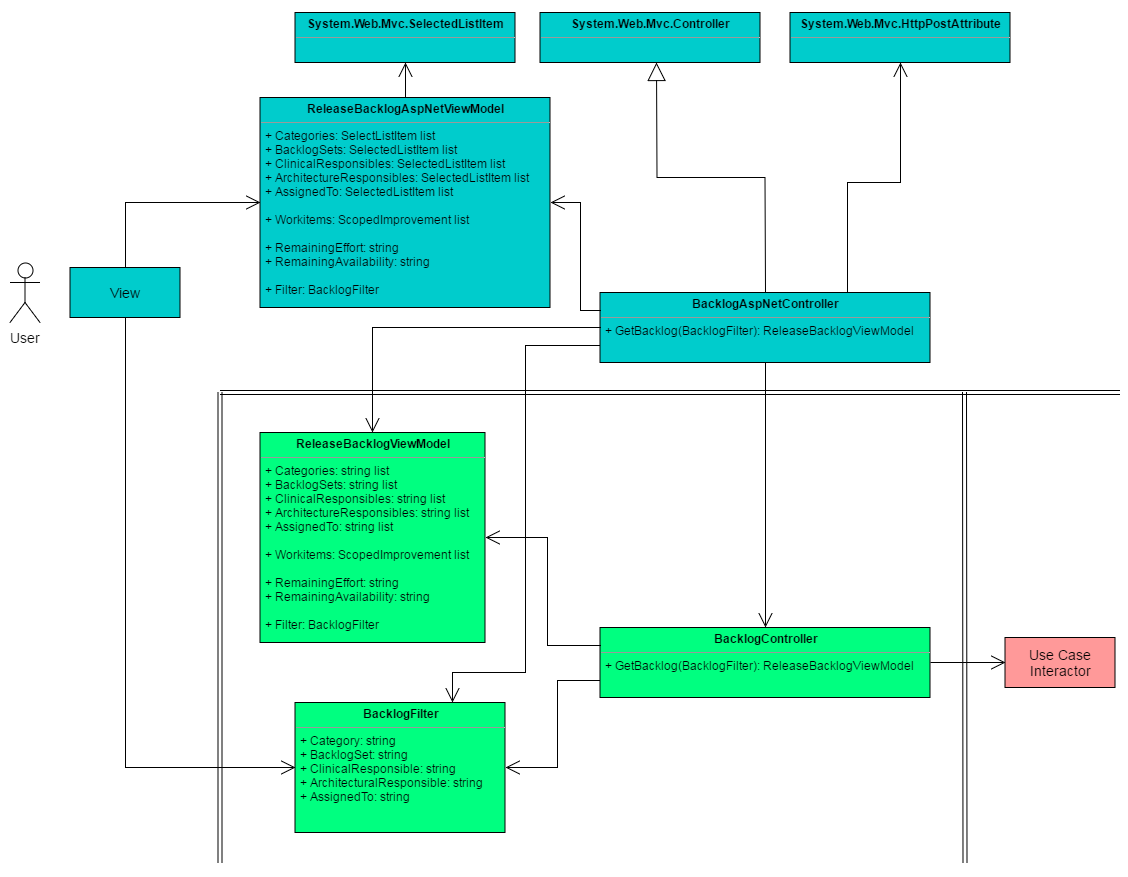
The BacklogController would still contain most of the data conversion logic between view and use case interactor. The
BacklogAspNetController would be a very thin adapter between the Asp.Net framework and my application controller converting between
Asp.Net types and custom types. The ReleaseBacklogViewModel would not reference any Asp.Net types any longer but only primitive and
custom types. The BacklogAspNetController would then convert the ReleaseBacklogViewModel into a
ReleaseBacklogAspNetViewModel in case I would want to continue using the Asp.Net rendering helper functions in the Razor templates.
In turn, if I would stop using these functions the ReleaseBacklogAspNetViewModel would not be needed.
This approach adds some more classes to the design in order to make it conform with the Dependency Rule. It even does more than just that. It also addresses testability: adding tests for the data conversions is now pretty easy as this logic has no dependency to the Asp.Net framework anymore. And this approach also addresses portability: If I would want to migrate to Asp.Net WebApi with pure HTML/JavaScript UI, my controller and presenter logic would be no longer impacted (ignoring the functions in the Razor templates for a second).
Note: There is still a small design flaw in the refactored design. The
ReleaseBacklogViewModelreturnsScopedImprovementwhich is a class defined in the use case layer. Reusing this class in the presenter - something which Uncle Bob considers as cheating - looks very convenient initially. The consequence of this design that I need some logic in the view to do the job of the presenter and “render” the properties ofScopedImprovementwhich makes the view smart again. But, in Clean Architecture, we want the view to be as dumb as possible so that there is no logic left which needs to be tested.Of course the Asp.Net MVC framework didn’t force me to choose this design but such frameworks provide some very convenient “magic” to get things done “fast” which in the longer run can slow you down. That’s why frameworks should be used with care.
I will later fix my design by simply using the helpers in the presenter directly instead of from the views, make the view model properties “stings only” and so the view dumb again.
Separating controller and presenter - Reloaded
And there is even more.
The previous post I closed with an approach separating controller and presenter in the context of Asp.Net MVC framework. This is the code I came up with:
type IOutputPort =
abstract HandleResponse : ReleaseBacklogResponse -> unit
type BacklogPresenter(callback) =
interface IOutputPort with
member this.HandleResponse response =
{
// data conversion logic skipped
}
|> callback
[<HttpPost>]
member this.Backlog (filter) =
let request = {
// data conversion logic skipped
}
let mutable vm = null
let presenter = new BacklogPresenter(fun x -> vm <- x) :> IOutputPort
request
|> BacklogInteractor.GetBacklog IoC.PlanningSerivce IoC.WorkItemRepository presenter
vm
With that approach my controller still knows about the presenter. I still think this is not a big deal but let’s see whether the new design can also improve this aspect. Here is an alternative proposal:
type BacklogAspNetController() =
inherit Controller()
[<HttpPost>]
member this.Backlog (filter) =
let mutable vm = null
let presenter = new BacklogPresenter(fun x -> vm <- x) :> IOutputPort
let interactor = BacklogInteractor.GetBacklog IoC.PlanningSerivce IoC.WorkItemRepository presenter
filter
|> BacklogController.CreateBacklog interactor
// TODO: convert ReleaseBacklogViewModel to ReleaseBacklogAspNetViewModel
vm
module BacklogController =
let CreateBacklog interactor filter =
let request = {
// data conversion logic skipped
}
request |> interactor
The BacklogPresenter is still injected into the use case interactor. This is now done in the BacklogAspNetController.
The BacklogInteractor is then injected into the BacklogController.
Note: In F# we use partial function application as a kind of dependency injection.
With this approach the application controller does not know any thing about the presenter and so get’s even closer to the
Clean Architecture. The BacklogAspNetController does not only bridge between Asp.Net framework and application, it also
takes care of wiring controller, presenter and interactor. Actually this should be the responsibility of the MAIN module but this
is a topic for an own post.
Project structure - Reloaded
As discussed in this post the current project structure of Athena looks like this:

I have considered this as a good compromise between the need for borders in the architecture and pragmatism. Now with the new insights on separating application controllers and Asp.Net framework, does the picture change?
Previously I haven’t created projects in the “frameworks” layer as I haven’t seen much code which would go there. The simplest approach to incorporate the new insight would be to add a new project in the frameworks layer per business aspect.
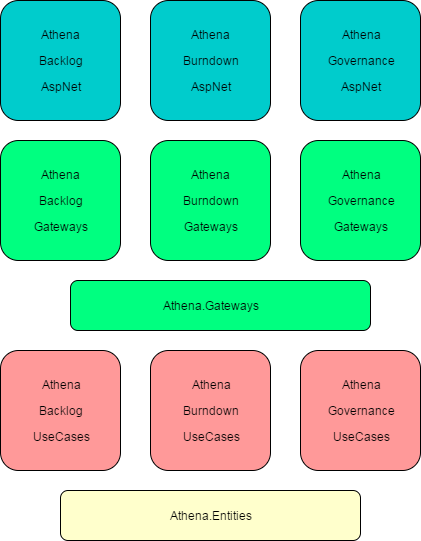
This would result in quite some projects. Can we simplify this?
The discussion in this post has shown how important borders are in an architecture. With that in mind a simplified project structure should draw a border between framework independent code and framework dependent code. That would give us
- one project per business aspect containing framework depending code
- one project per business aspect containing interface adapters and use cases
- single project containing entities
This approach clearly draws the two most important boarders between frameworks and application and between application specific logic and enterprise business rules (entities).
Which option should I choose?
Now that we have discussed multiple options with pros and cons - what would be the best option? As usual when talking about architecture and design there is only one correct answer: It depends.
It depends on the concrete project. It depends on the size of the project. Borders are more important in a project with 500 developers than in a project with one developer. It depends on the future plans of the project. Portability to new frameworks is not equally important for all project. It depends on the skills of your teams. More experienced developers see borders in the code even if they are not enforced with separate projects.
For Athena I currently still have Option 1 implemented in the code base but I plan to migrate to Option 3 as I anyhow want to migrate from Asp.Net MVC to Asp.Net WebApi with pure HTML/JavaScript UI.
How would you decide?
The "Implementing Clean Architecture" series
- How to implement the Clean Architecture?
- Implementing Clean Architecture - An Overview
- Implementing Clean Architecture - Make it scream
- Implementing Clean Architecture - What is a use case?
- Implementing Clean Architecture - Of controllers and presenters
- Implementing Clean Architecture - Are Asp.Net controllers "Clean"?
- Implementing Clean Architecture - Frameworks vs. Libraries
- Implementing Clean Architecture - Case Study: Sending e-mails
- Implementing Clean Architecture - To use or not to use MediatR?
